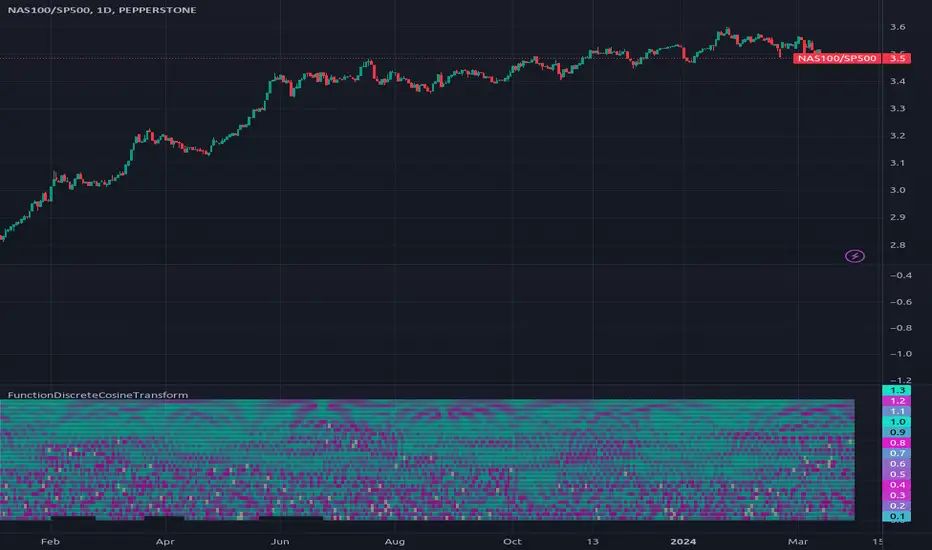PINE LIBRARY
FunctionDiscreteCosineTransform

Library "FunctionDiscreteCosineTransform"
Discrete Cosine Transform (DCT)
The Discrete Cosine Transform (DCT) is a mathematical algorithm that converts a series of samples of a signal, typically in the time domain, into another domain called the frequency or spectral domain. It's commonly used for data compression and image/video coding applications such as JPEG and MPEG standards.
The DCT works by multiplying the input sequence with specific cosine functions that are pre-defined and then summing up these products to obtain a new series of values, which represent the frequency components of the original signal. The main advantage of the DCT over other transforms like Fourier Transform is its ability to handle non-stationary signals (i.e., signals with varying statistical properties) more effectively due to its localized basis functions.
In simple terms, the DCT can be thought of as a way to break down an image or video into different frequency components and then compress them without losing too much information. This compression technique is essential for efficient transmission and storage of digital media files over the internet or on devices with limited memory capacity.
~Mixtral4x7b
___
Reference:
lcamtuf.substack.com/p/not-so-fast-mr-fourier
dct(data, len)
Discrete Cosine Transform.
Parameters:
data (array<float>): Data source.
len (int): Length of the sampling window.
Returns: List with frequency domain transformed information.
dct(data, len)
Discrete Cosine Transform.
Parameters:
data (float): Data source.
len (int): Length of the sampling window.
Returns: List with frequency domain transformed information.
idct(data, len)
Inverse Discrete Cosine Transform.
Parameters:
data (array<float>): Data source.
len (int): Length of the sampling window.
Returns: List with time domain transformed information.
idct(data, len)
Inverse Discrete Cosine Transform.
Parameters:
data (float): Data source.
len (int): Length of the sampling window.
Returns: List with time domain transformed information.
Discrete Cosine Transform (DCT)
The Discrete Cosine Transform (DCT) is a mathematical algorithm that converts a series of samples of a signal, typically in the time domain, into another domain called the frequency or spectral domain. It's commonly used for data compression and image/video coding applications such as JPEG and MPEG standards.
The DCT works by multiplying the input sequence with specific cosine functions that are pre-defined and then summing up these products to obtain a new series of values, which represent the frequency components of the original signal. The main advantage of the DCT over other transforms like Fourier Transform is its ability to handle non-stationary signals (i.e., signals with varying statistical properties) more effectively due to its localized basis functions.
In simple terms, the DCT can be thought of as a way to break down an image or video into different frequency components and then compress them without losing too much information. This compression technique is essential for efficient transmission and storage of digital media files over the internet or on devices with limited memory capacity.
~Mixtral4x7b
___
Reference:
lcamtuf.substack.com/p/not-so-fast-mr-fourier
dct(data, len)
Discrete Cosine Transform.
Parameters:
data (array<float>): Data source.
len (int): Length of the sampling window.
Returns: List with frequency domain transformed information.
dct(data, len)
Discrete Cosine Transform.
Parameters:
data (float): Data source.
len (int): Length of the sampling window.
Returns: List with frequency domain transformed information.
idct(data, len)
Inverse Discrete Cosine Transform.
Parameters:
data (array<float>): Data source.
len (int): Length of the sampling window.
Returns: List with time domain transformed information.
idct(data, len)
Inverse Discrete Cosine Transform.
Parameters:
data (float): Data source.
len (int): Length of the sampling window.
Returns: List with time domain transformed information.
파인 라이브러리
트레이딩뷰의 진정한 정신에 따라, 작성자는 이 파인 코드를 오픈소스 라이브러리로 게시하여 커뮤니티의 다른 파인 프로그래머들이 재사용할 수 있도록 했습니다. 작성자에게 경의를 표합니다! 이 라이브러리는 개인적으로 사용하거나 다른 오픈소스 게시물에서 사용할 수 있지만, 이 코드의 게시물 내 재사용은 하우스 룰에 따라 규제됩니다.
면책사항
해당 정보와 게시물은 금융, 투자, 트레이딩 또는 기타 유형의 조언이나 권장 사항으로 간주되지 않으며, 트레이딩뷰에서 제공하거나 보증하는 것이 아닙니다. 자세한 내용은 이용 약관을 참조하세요.
파인 라이브러리
트레이딩뷰의 진정한 정신에 따라, 작성자는 이 파인 코드를 오픈소스 라이브러리로 게시하여 커뮤니티의 다른 파인 프로그래머들이 재사용할 수 있도록 했습니다. 작성자에게 경의를 표합니다! 이 라이브러리는 개인적으로 사용하거나 다른 오픈소스 게시물에서 사용할 수 있지만, 이 코드의 게시물 내 재사용은 하우스 룰에 따라 규제됩니다.
면책사항
해당 정보와 게시물은 금융, 투자, 트레이딩 또는 기타 유형의 조언이나 권장 사항으로 간주되지 않으며, 트레이딩뷰에서 제공하거나 보증하는 것이 아닙니다. 자세한 내용은 이용 약관을 참조하세요.